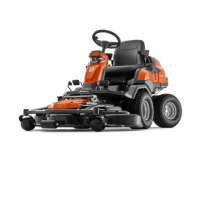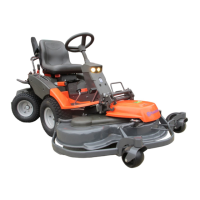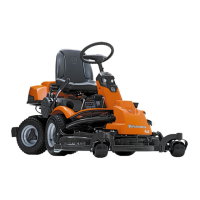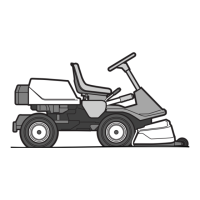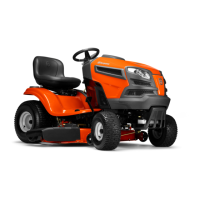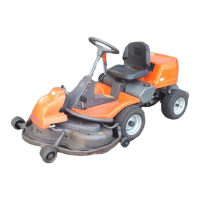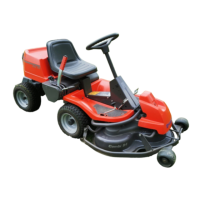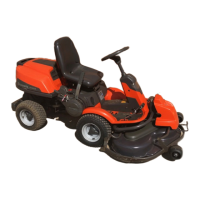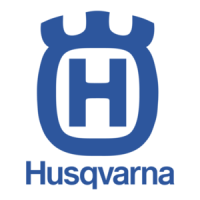
Do you have a question about the Husqvarna Rider PR 17 and is the answer not in the manual?
| Transmission Type | Hydrostatic |
|---|---|
| Drive Method | Rear-Wheel Drive |
| Cutting Height Steps | 7 |
| Blades | 3 |
| Hour Meter Type | Digital |
| Seat Suspension | Yes |
| Deck Material | Steel |
| Engine Cooling | Air |
| Fuel Type | Petrol |
| Rear Wheel Size | 16x6.5-8" |
| Collection System | Available as an accessory |
Guidelines for personnel and workshop equipment.
Hazards of fuel, compressed air, springs, and muffler use precautions.
Hazards and prevention of sparking from battery and starter circuits.
Lists and illustrates special tools for rider maintenance.
Safety, operation, and maintenance of a laser tachometer for speed measurement.
Technical specifications for PR 17, PR 17 AWD, R418 Ts AWD models.
Tyre dimensions and air pressure for various models.
Engine manufacturer, model, power, displacement, fuel, oil, and starting specs.
Manufacturer, type, and oil specifications for front and rear axles.
Voltage, battery, fuses, spark plug, and bulb types.
Max working pressure for hydraulic and steering servo systems.
Torque specifications for various bolts and components.
Cutting width, height, blade length, noise, width, and weight.
Specifications for parallelism, cutting height, and belt distances.
Specifications for brake cable, hydrostatic pedals, and lifting lever play.
Step-by-step guide for preparing and delivering the rider.
Engine oil change after 8 hours, hydraulic/drive system oil change after 50 hours.
Maintenance tasks for 25, 50, 100/200, and 300 hours of operation.
Maintenance tasks to be performed at least once each season.
Maintenance schedule with intervals and task descriptions.
Guidelines for dealers on informing customers about the machine.
Instructions for handling and unpacking the machine.
Steps for filling, charging, and fitting the battery.
Fitting steering wheel and checking engine oil level.
Checking hydraulic oil level and fitting wheels.
Checking cutting unit, test running, and starting engine.
Final checks, engine speed, and delivery paperwork.
Overview of articulated steering and model range.
Types of cutting units available for PR and PF models.
Location of machine, engine, and transmission serial numbers.
Information on Kawasaki engines, maintenance, and emissions.
Description of articulated and hydraulic power steering systems.
Hydrostatic transmission and AWD features.
Description of front and rear axle assemblies on AWD models.
Hydraulic pump integration and cutting unit function.
How the cutting unit is raised/lowered and height adjusted.
Step-by-step guide for engine removal.
Procedures for removing and fitting the engine belt pulley.
Instructions for lowering and tightening the engine fixtures.
Attaching and adjusting throttle and choke cables.
Steps for removing and fitting the fuel tank.
Procedure for changing engine oil and filter.
Checking and adjusting steering cable tension.
Step-by-step guide for replacing the power steering unit.
Procedures for removing and fitting the cable pulley.
Adjustment procedures for parking brake on different models.
Procedure for adjusting the hydrostatic transmission cable.
Adjusting cables and replacing steering bearings.
Removing pendulum shaft and replacing rear frame bushings.
Procedures for removing and assembling front axles on AWD models.
Steps to synchronise front and rear wheel drives.
Steps for replacing seals on outgoing shafts.
Procedures for replacing the hydrostatic transmission cable.
Bleeding procedures for AWD and non-AWD hydraulic systems.
Recommendations for changing transmission oil.
Adjusting the lever housing and related components.
Procedure for replacing the rear drive belt.
Procedures for replacing the hydraulic pump drive belt.
Procedures for replacing the centre belt.
Procedures for removing and assembling the equipment frame.
Steps for fitting the cutting unit to the machine.
Steps for removing the cutting unit.
Steps to place the cutting unit in service position.
Steps to return cutting unit from service position.
Adjusting unit parallelism and cutting height.
Adjusting the entire cutting height range.
Adjusting ground pressure of the cutting unit.
Procedure for replacing the V-belt on the cutting unit.
Removing blades, bearings, and servicing them.
Procedure for sharpening and balancing mower blades.
Steps to remove BioClip plug for rear ejection.
Diagram showing electrical component locations on PR 17/17 AWD.
Diagram showing electrical component locations on PF 21/21 AWD.
Schematic of the electrical system for PR 17 and PR 17 AWD.
Schematic of the electrical system for PF 21 and PF 21 AWD.
Comprehensive wiring diagram with color codes and connections.
Service procedures for ignition lock, hour meter, and fuses.
Steps for replacing light bulbs in the machine.
Explanation of safety system preventing starting or driving.
Adjustments and locations for microswitches.
Importance of cleanliness, oil types, and contamination prevention.
Guidelines for keeping hydraulic oil clean.
Procedures for clean handling of hydraulic components.
Diagrams showing hydraulic component locations for various models.
Step-by-step guide for replacing the lift cylinder.
Procedures for removing and fitting the hydraulic valve block.
Procedure for changing the hydraulic oil filter.
Steps for removing and replacing the control valve.
Detailed steps for dismantling and assembling the control valve.
Information on hose bundle, color coding, and part numbers.
Steps for changing the hydraulic oil cooler on PF 21 AWD.
Steps for replacing the cooling fan.
Troubleshooting steps for engine start failures.
Troubleshooting steps for poor engine performance.
Troubleshooting issues with low power or no drive.
Troubleshooting low power and abnormal noise conditions.
Troubleshooting transmission overheating, jerky starts, and brake issues.
Troubleshooting uneven mowing results and vibrations.
